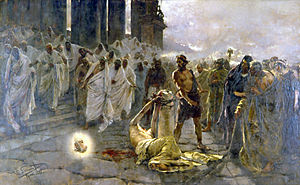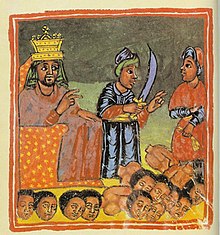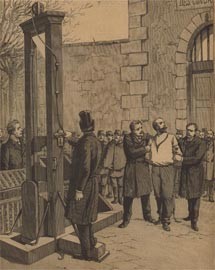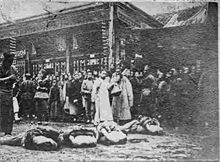| Revision as of 03:47, 14 December 2014 edit99.224.51.134 (talk) Undid revision 626692260 by 99.246.14.66 (talk) Unsourced.← Previous edit | Revision as of 20:04, 20 December 2014 edit undoDeepspace9odo (talk | contribs)235 edits →See alsoNext edit → | ||
| Line 217: | Line 217: | ||
| * ], a result from a decapitation. | * ], a result from a decapitation. | ||
| * ], a martyred saint who supposedly carries his/her severed head. | * ], a martyred saint who supposedly carries his/her severed head. | ||
| * ], a Hindu goddess who supposedly decapitates herself and holds her head in her hand. | * ], a Hindu goddess who supposedly decapitates herself and holds her head in her hand. | ||
| * ] | * ] | ||
| * ], a legendary ] ] weapon. | * ], a legendary ] ] weapon. | ||
Revision as of 20:04, 20 December 2014
"Decapitated" redirects here. For the Polish death metal band, see Decapitated (band).

| Decapitation |
|---|



Decapitation (from Latin, caput, capitis, meaning head) is the separation of the head from the body. This form of injury invariably results in death, as severing the head deprives all other organs of the involuntary functions that are essential for the body to function while the brain itself is deprived of oxygenated blood.
Beheading typically refers to the act of intentional decapitation, either as a means of murder or execution; it may be accomplished, for example, with an axe, sword, knife, wire, or by other more sophisticated means such as a guillotine. An executioner carrying out decapitations is called a headsman. Accidental decapitation can be the result of an explosion, car or industrial accident, improperly administered execution by hanging or other violent injury. Suicide by decapitation is rare, but not unknown. The national laws of Saudi Arabia, Yemen, Iran, and Qatar permit beheading, but Saudi Arabia is the only country that continues to behead its offenders.
The word decapitation can also refer, on occasion, to the removal of the head from a body that is already dead. This might be done to take the head as a trophy, for public display, to make the deceased more difficult to identify, for cryonics, or for other reasons.
History


Honor
Decapitation has been used as a form of capital punishment for millennia. The terms "capital offence", "capital crime", "capital punishment," derive from the Latin caput, "head", referring to the punishment for serious offences involving the forfeiture of the head; i.e., death by beheading. Decapitation by sword (or axe, a military weapon as well) was sometimes considered the honourable way to die for an aristocrat, who, presumably being a warrior, could often expect to die by the sword in any event; in England it was considered the privilege of noblemen to be beheaded. This would be distinguished from a dishonourable death on the gallows or through burning at the stake. In medieval England, the punishment for high treason was to be hanged, drawn and quartered but in the case of nobles and knights it was often commuted to beheading; female commoner traitors were burned at the stake.
In countries where beheading was the usual means of capital punishment, such as in Scandinavia, the noblemen would be beheaded with a sword, symbolizing their class as a military caste, thus dying by an instrument of war, while the commoners would be beheaded with an axe.
However, in some countries such as China, decapitation is considered as a less honourable capital punishment than other ways like the gallows or poisoning because of differing cultural values. For example, Chinese believe that to separate any part of the body from oneself intentionally is disrespectful to his or her ancestors, who have brought the person's life.
Painlessness
If the headsman's axe or sword was sharp and his aim was precise, decapitation was quick and was presumed to be a relatively painless form of death. If the instrument was blunt or the executioner clumsy, however, multiple strokes might be required to sever the head. The person to be executed was therefore advised to give a gold coin to the headsman to ensure that he did his job with care. Robert Devereux, 2nd Earl of Essex, and Mary, Queen of Scots, required three strikes at their respective executions. Margaret Pole, 8th Countess of Salisbury, is said to have required up to ten strokes before decapitation was achieved. This particular story may, however, be apocryphal, since highly divergent accounts exist. Historian and philosopher David Hume, for example, relates the following about her death:
She refused to lay her head on the block, or submit to a sentence where she had received no trial. She told the executioner, that if he would have her head, he must win it the best way he could: and thus, shaking her venerable grey locks, she ran about the scaffold; and the executioner followed her with his ax, aiming many fruitless blows at her neck before he was able to give the fatal stroke

To ensure that the blow would be fatal, executioners' swords usually were blade-heavy two-handed swords. Likewise, if an axe was used, it almost invariably would be wielded with both hands. In England a bearded axe was used for beheadings, with the blade's edge extending downwards from the tip of the shaft.
Finland's official beheading axe resides today at the Museum of Crime in Vantaa. It is a broad-bladed two-handed axe. It was last used when murderer Tahvo Putkonen was executed in 1825, the last execution in peacetime in Finland.
Guillotine
Decapitation by guillotine was a common mechanically-assisted form of execution, invented shortly before the French Revolution (although an earlier version of the guillotine, the Halifax Gibbet, was used in Halifax, England, from 1286 until the 17th century, and a version called the "Maiden" was used in Edinburgh during the 16th-18th centuries). The aim was to create a painless and quick form of execution that did not require great skill to carry out. The executioner, after chopping off the head, would hold it up to the crowd. There is dubious evidence that the head could remain conscious for up to ten seconds. The account of Dr. Beaurieux who observed the decapitation of a convict named Languille in 1905, may imply that the head could still see as he recounts "Next Languille's eyes very definitely fixed themselves on mine and the pupils focussed themselves" (A history of the guillotine, Alister Kershaw), though there are reasons to doubt the accuracy of Beaurieux's account. The French had a strict code of etiquette surrounding such executions; a man named Legros, one of the assistants at the execution of Charlotte Corday, was imprisoned for three months and dismissed for slapping the face of the victim after the blade had fallen in order to see whether any flicker of life remained. The guillotine was used in France during the French Revolution and remained the normal judicial method in both peacetime and wartime into the 1970s, although the firing squad was used in certain cases. France abolished the death penalty in 1981. The guillotine was also used in Algeria before the French relinquished control of it, as shown in Gillo Pontecorvo's film The Battle of Algiers. Another guillotine existed in Vatican City until recent years. It had been brought in by Napoleon's forces during the early 19th century; and, in 1870, the Pope still claimed the authority to use it. In recent times however, the Vatican has abolished capital punishment in its own jurisdiction, and recent Popes have condemned capital punishment wherever it is still practised.


German Fallbeil
Many German states had used a guillotine-like device known as a Fallbeil ("falling axe") since the 17th and 18th centuries, and decapitation by guillotine was the usual means of execution in Germany until the abolition of the death penalty in West Germany in 1949. In Nazi Germany, the guillotine was reserved for criminal convicts and political crimes including treason. A famous example of the guillotine being used was on the members of the White Rose resistance movement, a group of students in Munich that included siblings Sophie and Hans Scholl. Contrary to popular myth, executions were generally not conducted face-up, and chief executioner Johann Reichhart was peculiarly insistent on maintaining "professional" protocol throughout the era, having administered the death penalty during the earlier Weimar era. Nonetheless, the Nazis' use of the Fallbeil was chillingly routine. It is estimated that some 16,500 persons were guillotined in Germany and Austria between 1933 and 1945. This number includes resistance fighters both in Nazi Germany itself and in those countries that were occupied by them. As these resistance fighters were not part of any regular army they were considered common criminals and were in many cases taken to Germany and decapitated. Decapitation was considered a "dishonorable" death, unlike an "honorable" death: e.g., execution by firing squad.
The Fallbeil was used for the last time in West Germany in 1949, in East Germany in 1966.

Propaganda
Public display of the heads of executed persons, and of decapitated bodies, has served as a form of political propaganda or intimidation both in historical and in modern times.
Mass beheading
| Campaigns of Muhammad | |
|---|---|
| Further information: Military career of Muhammad |
The Islamic Prophet Muhammad made use of beheading (such as the beheading of Nadr ibn al-Harith). He also ordered mass beheadings. Muhammad ordered his followers to attack the Banu Qurayza because according to Muslim tradition he had been ordered to do so by the angel Gabriel. Al-Waqidi claims Muhammad had a treaty with the tribe which was torn apart. Stillman and Watt deny the authenticity of al-Waqidi. Al-Waqidi has been frequently criticized by Muslim writers, who claim that he is unreliable.
600-900 members of the Banu Qurayza were beheaded (Tabari, Ibn Hisham). Another source says all Males and 1 woman beheaded (Sunni Hadith). 2 Muslim's were killed
Historical practices by nation
Asia
China

In traditional China, decapitation was considered a more severe form of punishment than strangulation, although strangulation caused more prolonged suffering. This was because in Confucian tradition bodies were gifts from their parents, and so it was therefore disrespectful to their ancestors to return their bodies to the grave dismembered. The Chinese however had other punishments, such as dismembering the body into multiple pieces (similar to English quartering). In addition, there was also a practice of cutting the body at the waist, which was a common method of execution before being abolished in the early Qing dynasty due to the lingering death it caused. In some tales, people did not die immediately after decapitation.
India
The British officer John Masters recorded in his autobiography that Pathans in British India during former the Anglo-Afghan Wars would behead enemy soldiers who were captured, such as British and Sikh soldiers.
Pakistan
Pakistan's government employs death by hanging for capital punishment. Since 2007, militants from Tehrek-e-Taliban Pakistan have used beheadings as a form of punishment for opponents, criminals and spies in the north west region of Pakistan. Severed heads of opponents or government officials in Swat were left on popular street corners in order to terrorize local population. The beheadings have stopped in Swat since the military incursion and sweep-up that began in May 2009 and ended in June 2009. Three Sikhs were beheaded by the Taliban in Pakistan in 2010. Daniel Pearl was beheaded by his captors in the city of Karachi.
Despite official condemnation from the state itself, such beheading continues to flourish in the Taliban strongholds of Baluchistan and Khyber-Pakhtunkhwa and are often jarred and unprofessional resulting in increased pain for the victim.
Japan

In Japan, decapitation was a common punishment, sometimes for minor offences. Samurai were often allowed to decapitate soldiers who had fled from battle, as it was considered cowardly. Decapitation was historically performed as the second step in seppuku (ritual suicide by disembowelment). After the victim had sliced his own abdomen open, another warrior would strike his head off from behind with a katana to hasten death and to reduce the suffering. The blow was expected to be precise enough to leave intact a small strip of skin at the front of the neck—to spare invited and honored guests the indelicacy of witnessing a severed head rolling about, or towards them; such an event would have been considered inelegant and in bad taste. The sword was expected to be used upon the slightest sign that the practitioner might yield to pain and cry out—avoiding dishonor to him and to all partaking in the privilege of observing an honorable demise. As skill was involved, only the most trusted warrior was honored enough to take part. In the late Sengoku period, decapitation was performed as soon as the person chosen to carry out seppuku had made the slightest wound to his abdomen.
Decapitation (without seppuku) was also considered a very severe and degrading form of punishment. One of the most brutal decapitations was that of Sugitani Zenjubō (ja:杉谷善住坊), who attempted to assassinate Oda Nobunaga, a prominent daimyo in 1570. After being caught, Zenjubō was buried alive in the ground with only his head out, and the head was slowly sawn off with a bamboo saw by passers-by for several days (punishment by sawing; nokogiribiki ja:鋸挽き). These unusual punishments were abolished in the early Meiji era. This horrific scene is used in the last page of "SHOGUN" by James Clavell.
Korea
Historically, decapitation had been the most common method of execution in Korea, until it was replaced by hanging in 1896. Professional executioners were called mangnani (망나니) and belonged to the lowest class of people.
Thailand
In Southern Thailand, there were at least 15 cases where Buddhists were beheaded in 2005. Thai officials suspect the attackers are part of the South Thailand Muslim insurgency who are seeking to separate the south end part from the rest of Thailand.
Syria
Islamic Rebel forces have regularly carried out beheadings of people.
Europe
Celts
The Celts of western Europe long pursued a "cult of the severed head", as evidenced by both Classical literary descriptions and archaeological contexts. This cult played a central role in their temples and religious practices and earned them a reputation as head hunters among the Mediterranean peoples. Diodorus Siculus, in his 1st-century History had this to say about Celtic head-hunting:
They cut off the heads of enemies slain in battle and attach them to the necks of their horses. The blood-stained spoils they hand over to their attendants and striking up a paean and singing a song of victory; and they nail up these first fruits upon their houses, just as do those who lay low wild animals in certain kinds of hunting. They embalm in cedar oil the heads of the most distinguished enemies, and preserve them carefully in a chest, and display them with pride to strangers, saying that for this head one of their ancestors, or his father, or the man himself, refused the offer of a large sum of money. They say that some of them boast that they refused the weight of the head in gold.
Both the Greeks and Romans found the Celtic decapitation practices shocking and the latter put an end to them when Celtic regions came under their control.
According to Paul Jacobsthal, "Amongst the Celts the human head was venerated above all else, since the head was to the Celt the soul, centre of the emotions as well as of life itself, a symbol of divinity and of the powers of the other-world." Arguments for a Celtic cult of the severed head include the many sculptured representations of severed heads in La Tène carvings, and the surviving Celtic mythology, which is full of stories of the severed heads of heroes and the saints who carry their own severed heads, right down to Sir Gawain and the Green Knight, where the Green Knight picks up his own severed head after Gawain has struck it off, just as St. Denis carried his head to the top of Montmartre.
A further example of this regeneration after beheading lies in the tales of Connemara's St. Feichin, who after being beheaded by Viking pirates carried his head to the Holy Well on Omey Island and on dipping the head into the well placed it back upon his neck and was restored to full health.
Classical Antiquity
The ancient Greeks and Romans regarded decapitation as a comparatively honorable form of execution for criminals. The traditional procedure, however, included first being tied to a stake and whipped with rods. Axes were used by the Romans, and later swords, which were considered a more honorable instrument of death. Those who could verify that they were Roman citizens were to be beheaded, rather than undergoing the much more horrific experience of crucifixion. In the Roman Republic of the early 1st century BC, it became the tradition for the severed heads of public enemies — such as the political opponents of Marius and Sulla for example — to be publicly displayed on the Rostra in the Forum Romanum after execution. Perhaps the most famous such victim was Cicero who, on instructions from Mark Antony, had his hands (which had penned the Philippics against Antony) and his head cut off and nailed up for display in this manner.
— Martial, Epigram I:60 (Trans. by Garry Wills)Pothinus matched Mark Antony in crime:
They slew the noblest Romans of their time.
The helpless victims they decapitated,
An act of infamy with shame related.
One head was Pompey's, who brought triumphs home,
The other Cicero's, the voice of Rome.
Bosnia and Herzegovina
During the war in Bosnia and Herzegovina (1992–1995) there were a number of ritual beheadings of Serbs and Croats who were taken as prisoners of war by mujahedin members of the Bosnian Army. At least one case is documented and proven in court by the ICTY where mujahedin, members of 3rd Corps of Army BiH, beheaded Bosnian Serb Dragan Popović. Another case of beheadings of Serbs is documented to have happened on Kazani, on Trebević mountain above Sarajevo. Mostly Serb civilians were killed by beheading, and later on thrown in the Kazani pit. These actions were performed by several soldiers of the 10th mountain brigade under the command of Mušan Topalović - Caco.

Germany
- Fritz Haarmann, a serial killer from Hannover who was sentenced to death for killing 27 young men, was decapitated in April 1925. He was nicknamed "The Butcher from Hanover" and was rumored to have sold his victims' flesh to his neighbor's restaurant.
- In July 1931, notorious serial killer Peter Kürten, known as "The Vampire of Düsseldorf", was executed on the guillotine in Cologne.
- On 1 August 1933, in Altona, Bruno Tesch and three others were beheaded. These were the first executions in the Third Reich. The executions concerned the Altona Bloody Sunday (Altonaer Blutsonntag) riot, an SA march on 17 July 1932 that turned violent and led to 18 people being shot dead.
- Marinus van der Lubbe by guillotine in 1934 after a show trial in which he was found guilty of starting the Reichstag fire.
- In February 1935 Benita von Falkenhayn and Renate von Natzmer were beheaded with the axe and block in Berlin for espionage for Poland. Axe beheading was the only method of execution in Berlin until 1938, when it was decreed that all civil executions would henceforth be carried out by guillotine. However, the practice was continued in rare cases such as that of Olga Bancic in 1944. Beheading by guillotine survived in West Germany until 1949 and in East Germany until 1966.
- A group of three Catholic clergymen, Johannes Prassek, Eduard Müller and Hermann Lange, and an Evangelical Lutheran pastor, Karl Friedrich Stellbrink, were arrested following the bombing of Lübeck, tried by the People's Court in 1943 and sentenced to death by decapitation; all were beheaded on 10 November 1943, in the Hamburg prison at Holstenglacis. Stellbrink had explained the raid next morning in his Palm Sunday sermon as a "trial by ordeal", which the Nazi authorities interpreted to be an attack on their system of government and as such undermined morale and aided the enemy.
- In February 1943, American academic Mildred Harnack and the university students Hans Scholl, Sophie Scholl, and Christoph Probst of the White Rose protest movement, were all beheaded by the Nazi State. Four other members of the White Rose, an anti-Nazi group, were also executed by the People's Court later that same year. The anti-Nazi Helmuth Hübener was also decapitated by People’s Court order.

- In May and September 1943 several Dutch members of the Wollweber League were beheaded with the axe.
Altogether, over 40,000 Germans were legally executed under the Nazi regime, most of them by guillotine.
- In 1966, former Auschwitz doctor Horst Fischer was executed by the German Democratic Republic by guillotine, the last executed by this method outside France. Beheading was subsequently replaced by shooting in the neck.
France
In France, until the abolition of capital punishment in 1981, the main method of execution had been by beheading by means of the guillotine. Other than a small number of cases where a firing squad was used, the guillotine was the only legal method of execution from 1789, when it was introduced during the French Revolution, until 1981. In 1981, President François Mitterrand abolished capital punishment and issued commutations for those whose sentences had not been executed.
The last person to be beheaded by the guillotine was Hamida Djandoubi, in 1977. Djandoubi's execution was the last legal beheading in a democratic country, and the last use of guillotine in the world.
Nordic countries
In Nordic countries, decapitation was the usual means of carrying out capital punishment. Noblemen were beheaded with a sword, and commoners with an axe. The last executions by decapitation in Finland in 1825, Norway in 1876, Faroe Islands in 1609, and in Iceland in 1830 were carried out with axes. The same was the case in Denmark in 1892. Sweden continued the practice for a few decades, executing its second to last criminal - mass murderer Johan Filip Nordlund - by manual cleaver in 1900. It was replaced by guillotine, which was used for the first and only time on Johan Alfred Ander in 1910.
Nordlund's execution was the last (legal) manual beheading in the Western world except for in Germany, where it prevailed until the days of World War II (see above).
The official beheading axe of Finland resides today in the Museum of Crime, Vantaa.
Spain
In Spain executions were carried out by various methods including strangulation by the garrotte. In the 16th and 17th centuries, noblemen were sometimes executed by means of beheading. They were tied to a chair on a scaffold. The executioner used a knife to cut the head from the body. It was considered to be a more honourable death if the executioner started with cutting the throat.
North America
Mexico

Miguel Hidalgo y Costilla, Ignacio Allende, José Mariano Jiménez and Juan Aldama were tried for treason, executed by firing squad and beheaded during the Mexican independence in 1811. Their heads were on display on the four corners of the Alhóndiga de Granaditas, in Guanajuato.
Recently during the Mexican Drug War some Mexican drug cartels have turned to decapitation and beheading of rival cartel members as a method of intimidation.


United States
The Utah Territory permitted a person sentenced to death to choose beheading as a means of execution. No person chose that option, and it was dropped when Utah became a state.
Canada
Decapitation has never been practiced under Canadian law.
Middle East
Saudi Arabia
See also: Capital punishment in Saudi ArabiaSaudi Arabia is the only country that carries out beheadings of its offenders. They are commonly performed outside of mosques in major cities after prayer services on Friday, the Muslim holy day. The punishment derives from the country's Wahhabi interpretation of the Islamic religious laws of Shariah. Crimes such as of rape, murder, apostasy, sorcery, armed robbery, drug trafficking and repeated drug use are punishable by beheading.
According to Amnesty International, at least 79 people were executed in the kingdom in 2013. Foreigners are not exempt, accounting for "almost half" of executions in 2013.
Iraq
See also: Beheading videoThough not officially sanctioned, legal beheadings were carried out against at least 50 prostitutes and pimps under Saddam Hussein as late as 2000.
Beheadings have emerged as another terror tactic especially in Iraq since 2003. Civilians have borne the brunt of the beheadings, although U.S. and Iraqi military personnel have also been targeted. After kidnapping the victim, the kidnappers typically make some sort of demand of the government of the hostage's nation and give a time limit for the demand to be carried out, often 72 hours. Beheading is often threatened if the government fails to heed the wishes of the hostage takers. Frequently the crude beheadings are videotaped and made available on the Internet. One of the most publicized of such executions was that of Nick Berg.
Judicial execution is practiced in Iraq, but is generally carried out by hanging.
Physiology of death by decapitation
Decapitation is quickly fatal to humans and most other animals. Unconsciousness occurs within 10 seconds without circulating oxygenated blood (brain ischemia). Cell death and irreversible brain damage occurs after 3-6 minutes with no oxygen due to excitotoxicity. Some anecdotes suggest more extended persistence of human consciousness after decapitation:
, the spasmodic movements ceased... It was then that I called in a strong, sharp voice: "Languille!" I saw the eyelids slowly lift up, without any spasmodic contractions – I insist advisedly on this peculiarity – but with an even movement, quite distinct and normal, such as happens in everyday life, with people awakened or torn from their thoughts... eyelids lifted and undeniably living eyes fixed themselves on mine with perhaps even more penetration than the first time.
— Gabriel Beaurieux, A History of the Guillotine
But most doctors consider this unlikely and consider such accounts to be misapprehensions of reflexive twitching rather than deliberate movement, since deprivation of oxygen must cause nearly immediate coma and death (" probably lost within 2-3 seconds, due to a rapid fall of intracranial perfusion of blood.").
However, there are reports of patients remaining conscious for up to 12 seconds after cardiac arrest, gradually losing consciousness within that time due to lack of oxygen replacement to the brain (which reaches 0% within 12 seconds), therefore it is conceivable that a person may remain conscious for up to that period of time after decapitation (assuming that no blunt trauma took place at the time of decapitation).
Some animals (such as cockroaches) can survive decapitation, and die not because of the loss of the head directly, but rather because of starvation. Although head transplantation by the reattachment of blood vessels has been successful with other animals, a fully functional reattachment of a severed human head (including repair of the spinal cord, muscles, and other critically important tissues) has not yet been achieved.
Notable people who have been beheaded
Main article: List of people who were beheadedSee also
- Beheading video
- Blood squirt, a result from a decapitation.
- Cephalophore, a martyred saint who supposedly carries his/her severed head.
- Chhinnamasta, a Hindu goddess who supposedly decapitates herself and holds her head in her hand.
- Dismemberment
- Flying guillotine, a legendary Chinese assassins' weapon.
- Jean-François de la Barre
- Headhunting
- Internal decapitation, where the skull is dislodged from the spine; a generally, but not always, fatal injury.
- Islamist beheading
- List of methods of capital punishment
- List of people who were beheaded
References
- Merriam-Webster
- "Blows Head Off with Dynamite?". The Rhinelander Daily News. 2 April 1937. p. 7. Retrieved 29 September 2014 – via Newspapers.com.

- see Isadora Duncan
- "Guillotine death was suicide". BBC News. 24 April 2003. Retrieved 26 September 2008.
- ^ Weinberg, Jon (Winter 2008). "Sword of Justice? Beheadings Rise in Saudi Arabia". Harvard International Review.
- Francis Larson. Severed: a history of heads lost and heads found Liveright, 2014.
- Ann Fabian."Losing our Heads" (review of Larson,s Severed Chronicle of Higher Education Dec. 1, 2014 Accessed Dec. 1, 2014.
- Webster's Revised Unabridged Dictionary, edited by Noah Porter, published by G & C. Merriam Co., 1913
- For Devereux's execution: Smollett,T.:"A Complete History of England, from the Descent of Julius Caesar ..., Volum 4" London 1758, p.488
- For Mary, Queen of Scots:Cheetham,J.K.:"On the Trail of Mary Queen of Scots" Glasgow 2000, p.161
- The Complete Peerage, v. XII p. II, p. 393
- Hume, D.:"The history of the reign of Henry the eighth" London 1792, p.151
- Otonkoski, Pirkko-Leena. "Henkirikoksista kuolemaan tuomittujen kohtaloita vuosina 1824-1825 Suomessa". Genos (in Finnish). 68. The Genealogical Society of Finland: 55–69, 94–95. Archived from the original on 23 August 2011. Retrieved 14 December 2010.
- Bellows, Alan (8 April 2006). "Lucid Decapitation". Damn Interesting. Retrieved 16 August 2011.
- Dash, Mike. 'Some experiments with severed heads.' A Blast From The Past, 25 January 2011. Retrieved 30 July 2011.
- Mignet, François, History of the French Revolution from 1789 to 1814, (1824).
- The Life of Muhammad (Sirat Rasul Allah), Oxford University Press, 2002, pp. 461–464, ISBN 978-0-19-636033-1
{{citation}}: Unknown parameter|authors=ignored (help) - Peters, Muhammad and the Origins of Islam, p. 222-224.
- Stillman, The Jews of Arab Lands: A History and Source Book, pp. 137-141.
- ^ Mubarakpuri, The Sealed Nectar, pp. 201-205. (online)
- ^ Ibn Kathir, Saed Abdul-Rahman (2009), Tafsir Ibn Kathir Juz'21, MSA Publication Limited, p. 213, ISBN 9781861796110(online)
- Subhash C. Inamdar (2001), Muhammad and the Rise of Islam: The Creation of Group Identity, Psychosocial Press, p. 166 (footnotes), ISBN 1887841288
- Stillman, The Jews of Arab Lands: A History and Source Book, pp. 14-16.
- Encyclopedia of Islam, section on "Muhammad"
- Watt, Encyclopaedia of Islam, Section on "Kurayza, Banu".
- Al Tabari, Michael Fishbein (translator) (1997), Volume 8, Victory of Islam, State University of New York Press, pp. 35–36, ISBN 9780791431504
{{citation}}:|author=has generic name (help) - Sunan Abu Dawood, 14:2665
- Sahih al-Bukhari, 4:52:280
- 原來斬頭係唔會即刻死既(仲識講野)中國有好多斬頭案例!!
- “无头人”挑战传统医学 人类还有个“腹脑”?
- 福州晚報
- 换人头
- John Masters (1956). Bugles and a tiger: a volume of autobiography. Viking Press. p. 190. Retrieved 5 April 2011.
- Michael Barthorp, Douglas N. Anderson (1996). The Frontier ablaze: the North-west frontier rising, 1897-98. Windrow & Greene. p. 12. ISBN 1-85915-023-3. Retrieved 5 April 2011.
- John Clay (1992). John Masters: a regimented life. the University of Michigan: Michael Joseph. p. 62. ISBN 0-7181-2945-8. Retrieved 5 April 2011.
- John Masters (13 June 2002). Bugles and a Tiger. Cassell Military (13 June 2002). p. 190. ISBN 0-304-36156-9. Retrieved 5 April 2011.
- SGPC, Punjab government condemn Sikh beheading in Pakistan
- Asahi Dictionary of Japanese Historical Figures
- Doosan Encyclopedia
- "Buddhist decapitated in Thailand". Herald Sun. 26 July 2005. Archived from the original on 24 May 2007. Retrieved 15 February 2008.
- "Man beheaded, two shot dead the man was later found in a shallow grave". News Limited. 14 October 2005. Archived from the original on 20 March 2007. Retrieved 15 February 2008.
- "Syrian Rebels used a child to behead a prisoner". Human Rights Investigation. 12 December 2012. Retrieved 22 March 2013.
- Cunliffe, Barry (2010), Druids: A Very Short Introduction, Oxford University Press, pp 71-72.
- Cunliffe, Op. cit., pg 72.
- Paul Jacobsthal Early Celtic Art
- UN - TRIBUNAL CONVICTS ENVER HADZIHASANOVIC AND AMIR KUBURA Press Release, March 2006
- Archived 2009-08-05 at the Wayback Machine
- asfpg ~ Altonaer Stiftung für philosophische Grundlagenforschung
- "Movies: About Das Beil Von Wandsbek". The New York Times.
- Il y a 30 ans, avait lieu la dernière exécution (in French), Le Nouvel Observateur, 10 September 2007, retrieved 28 March 2014
{{citation}}: Unknown parameter|trans_title=ignored (|trans-title=suggested) (help) (Google translation) - Execution of the Marquess of Ayamonte on the 11th. of December 1645 Described in "Varios relatos diversos de Cartas de Jesuitas" (1634–1648) Coll. Austral Buones Aires 1953 en Dr. J. Geers "Van het Barokke leven", Baarn 1957 Bl. 183 - 188.
- George W. Grayson (February 2009). "La Familia: Another Deadly Mexican Syndicate". Foreign Policy Research Institute. Archived from the original on 15 September 2009.
- Miller, Wilbur R. (2012). The Social History of Crime and Punishment in America: An Encyclopedia. SAGE. p. 1856. ISBN 9781412988766. OCLC 768569594.
- "Saudi executioner tells all". BBC News. 5 June 2003. Retrieved 11 July 2011.
- ^ "Death Sentences and Executions 2013" (PDF). Amnesty International. 2014. Retrieved 19 September 2014.
- http://www.aftonbladet.se/nyheter/article10190019.ab
- "The Terrorist as Auteur"
- "Footage of the Beheading of Nick Berg"
- Gabriel Beaurieux, writing in 1905, quoted in Kershaw, Alister (1958). A History of the Guillotine. John Calder. ISBN 9781566191531., cited by "Losing One's Head: A Frustrating Search for the 'Truth' about Decapitation". The Chirurgeon's Apprentice. Retrieved 8 April 2014.
- Hillman, Harold (27 October 1983). "An Unnatural Way to Die". New Scientist. Reed Business Information: 276–278. Cited in Shanna Freeman. "Top 10 Myths About the Brain". How Stuff Works. p. 5: Your Brain Stays Active After You Get Decapitated. Retrieved 8 April 2014.
- Fact or Fiction?: A Cockroach Can Live without Its Head: Scientific American
- Roach, Mary (2004). Stiff: The Curious Lives of Human Cadavers. W.W. Norton & Co. p. 208. ISBN 0-393-32482-6.
![]() This article incorporates text from a publication now in the public domain: Chambers, Ephraim, ed. (1728). Cyclopædia, or an Universal Dictionary of Arts and Sciences (1st ed.). James and John Knapton, et al.
This article incorporates text from a publication now in the public domain: Chambers, Ephraim, ed. (1728). Cyclopædia, or an Universal Dictionary of Arts and Sciences (1st ed.). James and John Knapton, et al. {{cite encyclopedia}}: Missing or empty |title= (help)